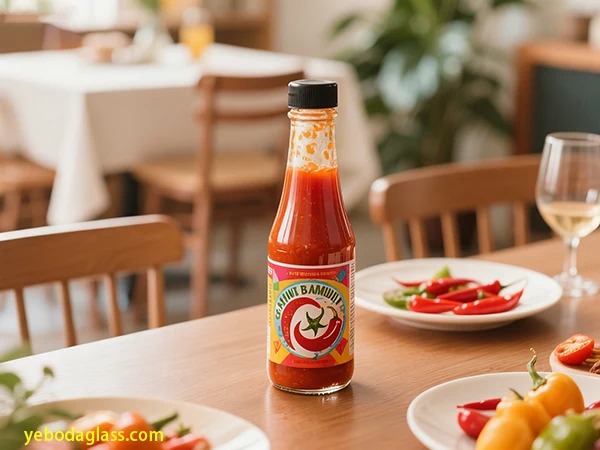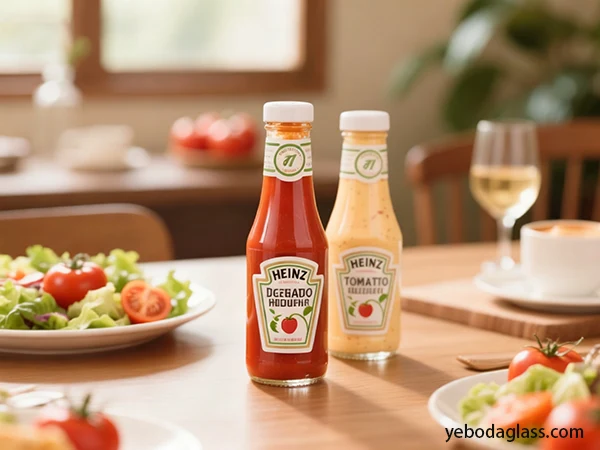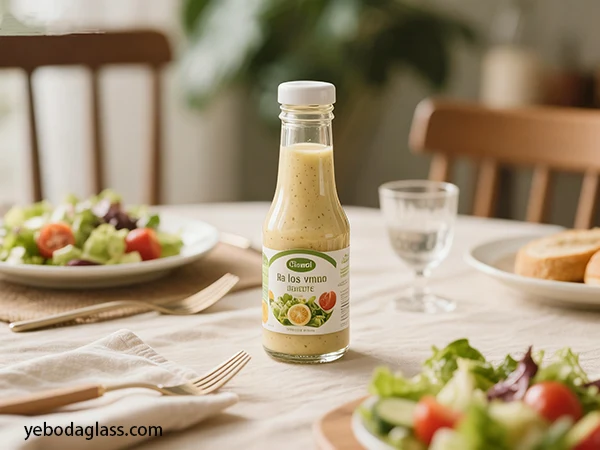Executive Summary
This report offers an extensive strategic vision for the subsequent food production facilities generation, tailored explicitly for the vibrant and competitive hot sauce bottles factory sector. The main argument indicates that manufacturing systems of the future should become profoundly integrated digital and physical ecosystems—made for hyper-efficiency, adaptability, and circular sustainability. Normal operational benchmark like Overall Equipment Effectiveness (OEE) is not enough anymore. The new Sustainable Operational Excellence paradigm gauges success in a balanced way by combining financial productivity, environmental friendliness, and supply chain resilience. This model changes the way a glass hot sauce bottles factory works—less focus on the factory itself and more on the network of modular production cores, predictive digital twins, autonomous logistics, blockchain traceability, and revolutionary business models such as Packaging-as-a-Service (PaaS). Most importantly, the outcome of such an advanced technology adoption is not a simple factory of hot sauce bottles which operates in an optimized way. It rather represents an adaptive, data-driven, and transparent ecosystem that can maintain its competitive advantage under these tougher conditions of regulatory pressure, consumer consciousness, and circular economy trends.

The Agile Production Core: A Modular, Multi-Material Bottling Architecture
From Linear to Modular Design
Conrad Future hot sauce bottles factory concept is centered around a modular, decoupled production architecture that takes the place of traditional assembly lines with dynamic, flexible “process islands.” These islands are each capable of independently handling ingredient preparation, bottle rinsing, filling, capping, and labeling—thus enabling on-the-fly customization and zero downtime. This architecture has the advantage that one can switch between making glass bottles, PET bottles, or some other new-fangled packaging at will. The modularity provides scope for quick changes in the product type by which manufacturers are enabled to fit niche market needs, seasonal variations, and custom branding requests with a speed that was previously unthinkable.
Decoupled Process Islands
The production island is each a fully automated, smart station:
- Ingredient Preparation & Mixing: Automated dosing units take care of the ingredients from chili puree to spice blends with absolute precision.
- Bottle Handling: Robotic depalletizers operate on glass and rPET bottles utilizing AI-guided vision for perfect alignment.
- Filling & Capping: The servo-driven nozzles change to different viscosities and bottle shapes to achieve the required filling accuracy.
- Labeling & Coding: Digitally printing and labeling machines put on unique QR codes and designs for every batch or bottle.
In removing the inflexible physical chain, the factory acquires operational resilience—the other modules can keep working, thus throughput is maintained throughout the production ecosystem if one module is temporarily stopped.
Robotics for Ultimate Flexibility
Robotics and cobots are at the core of this change. AI-equipped grippers instantly identify glass hot sauce bottles, change the settings, and if they’re switching from one product to another, they even adjust the operations. What used to be changeovers of several hours are now changeovers of a few minutes, thus enabling the efficient production of custom bottles, private labels, or small-batch gourmet sauces that are essential for modern e-commerce and B2B fulfillment. The ability to change so quickly at such a high level of production is what basically characterizes a next-generation hot sauce bottles factory: a production ecosystem that is not only scalable but also environmentally friendly.
The Unified Digital Twin: Predictive Operations and Resource Management
The Hot Sauce Bottles Factory’s Digital Nervous System
The digital twin is the factory’s central brain – a perpetually real-time updated virtual model that reflects every physical unit, process, and resource in the glass hot sauce bottles factory. It gets the information from the thousands of IoT sensors that are placed in the production lines, conveyors, motors, and storage units and through that, it unites various operational levels:
- The Physical Asset Layer is looking at equipment health and energy consumption.
- The Process Flow Layer is tracking every material movement and recipe change.
- The Infrastructure Layer is freeing HVAC, lighting, and water systems from their emissions by optimizing them for that and more.
Predictive and Prescriptive Intelligence
The AI engine on the other hand, goes through this information to deliver both predictive maintenance and prescriptive actions. For example:
- Predictive Maintenance: Recognition of unusual motor conditions well in advance of failure, thus allowing repair work to be scheduled automatically.
- Dynamic Scheduling: Adjusts production plans in case of energy price hikes or delay in arrival of raw material.
- Resource Optimization: Uses the energy that is generated during pasteurization for that purpose of heating the water used in the cleaning process, thus reducing the total consumption by up to 40%.
Basically, the digital twin converts the hot sauce bottles factory into a self-learning, self-regulating entity that is able to operate with minimal human intervention thus it also makes possible maximization of output consistency.

Closed-Loop Intra-Logistics: The Autonomous and Circular Flow of Materials
Autonomous Mobility Systems
Each production island is linked to a fleet of AMRs (Autonomous Mobile Robots) that operate the delivery of bottles, caps, and ingredients in a just-in-time manner. Their interaction through the digital twin enables them to keep the production line open, avoid traffic, and give the required operations the first place in the queue.
Circular Material Loops
The logistics system not only moves goods—it recirculates resources. Waste glass, defective bottles, organic residues, and water are all recovered and reintroduced into production. Molten glass that comes from rejected bottles is made pure and sent back to the glass manufacturers. Organic waste is converted through anaerobic digestion into biogas. Water is being saved by means of reverse osmosis installed for non-critical reuse. The model takes the factory of hot sauce bottles to the next level of a closed-loop, circular ecosystem where waste is minimized and profit maximized.
End-to-End Traceability: Blockchain-Enabled Transparency
The “Pepper-to-Bottle” Digital Ledger
By means of blockchain technology, a digital passport accompanies each batch of glass hot sauce bottles recording every step of the way from pepper planting to retail delivery. Farmers upload data about the harvest; transporters record the environmental conditions; and the factory logs the quality metrics, batch codes, and packaging details. After bottling, a unique QR code is assigned to each product to ensure traceability.
Building Consumer Trust and Food Safety
Consumers may use their phones to scan the QR code that discloses farm origins, sustainability scores, and even carbon footprints. Blockchain guarantees that any contamination problem can be traced exactly to its origin for regulators and manufacturers, thus allowing them to initiate a targeted recall without affecting the rest of the market. This digital record of the product journey not only assures supply chain security but also helps to brand loyalty—very important in the fiercely competitive global market of glass bottles and specialty sauces.
Advanced Materials and Packaging-as-a-Service (PaaS)
Material Innovation in Sustainability
The glass hot sauce bottles factory of tomorrow is characterized by intelligent material utilization. Although glass continues to be the best in terms of clarity, hygiene, and recyclability, the innovation is more about light-weighting and hybrid material usage. By using lightweighted glass bottles material usage can be reduced by up to 30%, thus energy and transport costs are dramatically cut without losing the strength of the product. In the case of flexible packaging, high-barrier rPET and biodegradable biopolymers (such as PHA) serve as lightweight and environmentally friendly packaging options. One such future-oriented manufacturer Yeboda, is a prime example of leadership in the field of eco-friendly glass packaging. As a hot sauce bottles factory partner, Yeboda provides top-notch quality control, precision molding for standardization, and a dedication to closed-loop recycling collaborations. Their lightweight glass innovations position them as an essential partner for brands that are making a circular manufacturing transition.
Packaging-as-a-Service (PaaS): Redefining Ownership
The most revolutionary idea regarding the management of packaging is PaaS, where the leasing of bottles is done instead of the selling of them. By using this method the provider can keep the ownership and be in charge of the whole cycle of the bottles delivery, use, return, cleaning, and reuse. This move leads to the production of more durable, reusable bottles, while manufacturers get rid of packaging waste and lower capital expenditure. A PaaS factory for glass hot sauce bottles will be instrumental in turning sustainability into a profitable, regenerative system, instead of a cost center.
| Packaging Material | Carbon Footprint (Manufacturing) | Recyclability / Circularity | Barrier Properties (O₂) | Material Cost |
|---|---|---|---|---|
| Lightweighted Glass | Medium-High (reduces with cullet %) | Excellent (infinitely recyclable) | Excellent | Medium |
| High-Barrier rPET | Medium (lower than virgin PET) | Good (chemically/mechanically recyclable) | Good to Excellent | Low-Medium |
| Bio-Polymers (PHA) | Low | Good (compostable/biodegradable) | Fair to Good | High |

Strategic Implementation Roadmap
Phase 1: Foundational Digitization (Years 1–2)
- Use modular robotics to deploy bottling and filling.
- Create a Manufacturing Execution System (MES) for OEE tracking.
- Equip critical machines with IoT sensor units.
- Return on Investment (ROI): Over 20% OEE enhancement, lengthening of time between breakdowns.
Phase 2: Integrated Digital Twin & Logistics (Years 3–4)
- Develop a comprehensive digital twin to enhance predictive analytics capabilities.
- Introduce autonomous mobile robots (AMR) powered logistics alongside intelligent waste recovery stations.
- Use ingredient blockchain internally for traceability on a trial basis.
- Return on Investment (ROI): 40% less resource consumption, 95% waste redirected to recycling.
Phase 3: External Integration & Circular Ecosystem (Years 5+)
- Implement blockchain-based traceability that spans suppliers as well as retailers.
- Start pilot programs of PaaS with selected partners.
- Procure more bio-based as well as recycled materials.
- Return on Investment (ROI): Additional income from upcycling, enhanced brand differentiation, and increased longevity.
Such a roadmap turns a hot sauce bottles factory into an innovation hub—agile, circular, and digitally intelligent.
The Future Vision of the Glass Hot Sauce Bottles Factory
Resilient by Design
The modern hot sauce bottles factory is designed to be flexible and durable, functioning like a living organism that continually learns and develops. With the help of AI-driven production planning, modular robotics, and renewable energy solutions, the factory not only reaches peak performance but also keeps its carbon footprint very low. Flexible production lines enable quick change from one bottle size, shape, or style to another, thus the manufacturers are able to respond to the market demand changes without the need of expensive downtime.
Transparency as the New Currency
Transparency is a synonym for trust in the conscious consumer market of this time. The use of blockchain-enabled supply chain tracking by a leading hot sauce bottles factory allows the complete visibility of the whole process—from raw glass sourcing to finished bottle delivery. Such traceability not only serves as a very good prevention measure of fraud and guarantee of product safety but also acts as a brand strengthening tool for wholesalers and retailers. Consumers have the possibility to verify each batch of products thereby ensuring quality, compliance, and sustainability standards have been consistently met.
Data-Driven Circularity
Sustainability has become a necessity rather than an option and at the same time it’s a competitive advantage. In the most advanced hot sauce bottles factory, the entire material flow, starting from recycled glass cullet through to energy consumption and biogas recovery, is digitally monitored and optimized. Data-driven circular processes that are in place at the factory contribute to the reduction of waste, cost savings, and increased resource efficiency. Constant performance evaluation gives the factory the opportunity to real-time operational upgrades, thus enabling it to become a truly circular, eco-efficient production model that is able to future-proof businesses competing in the glass bottle market.
Global Implications and Industry Benchmarking
Setting New Standards in Glass Bottle Manufacturing
These innovations that the factory producing hot sauce bottles implemented have become a role model for the broader industries, e.g., beverages, condiments, and cosmetics. The shift to modular, data-driven factories is no longer a matter of choice but a must for maintaining competitiveness.
Collaborative Ecosystems
The success of the future will depend on collaboration—joint work of material scientists, AI developers, logistics partners, and glass manufacturers. The hot sauce bottles factory turns into not only a production site but also a sustainability lab, thus, collaborating in the development of the next era of circular manufacturing.

Conclusion
The future hot sauce bottles factory through the integration of precision engineering, digital intelligence, and environmental ethics, essentially changes the face of manufacturing. It is a complete industrial model reboot, to name a few features: modular agility, predictive resource optimization, blockchain traceability, Packaging-as-a-Service. Connecting these tools allows companies to attain Sustainable Operational Excellence—economic performance, environmental impact, and consumer trust, all in harmony. Simply put, the glass hot sauce bottles factory of the future is not just the place where bottles are made—it’s the place where innovation, transparency, and sustainability come together to create the future of food packaging.



